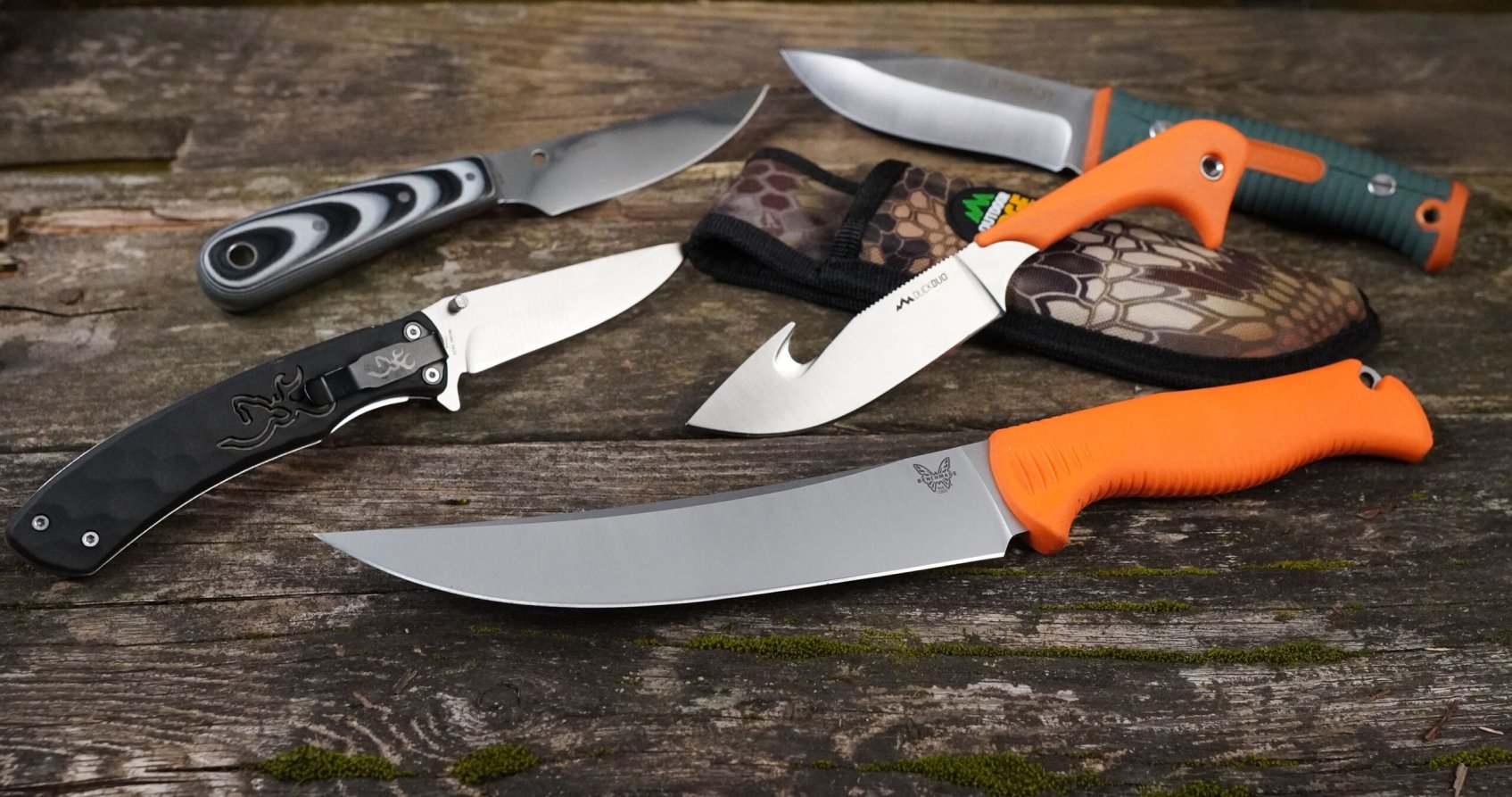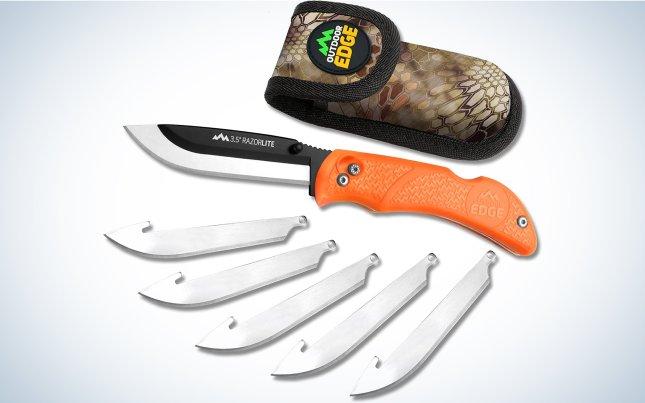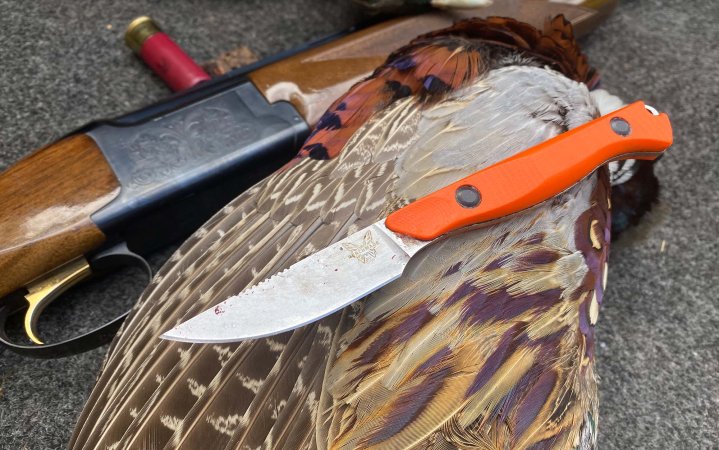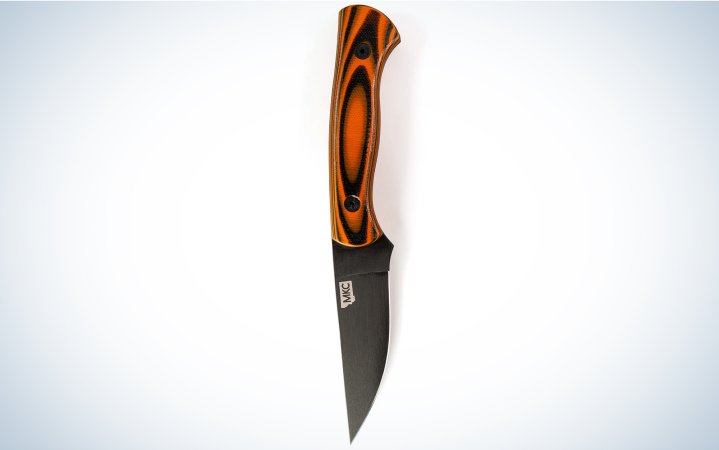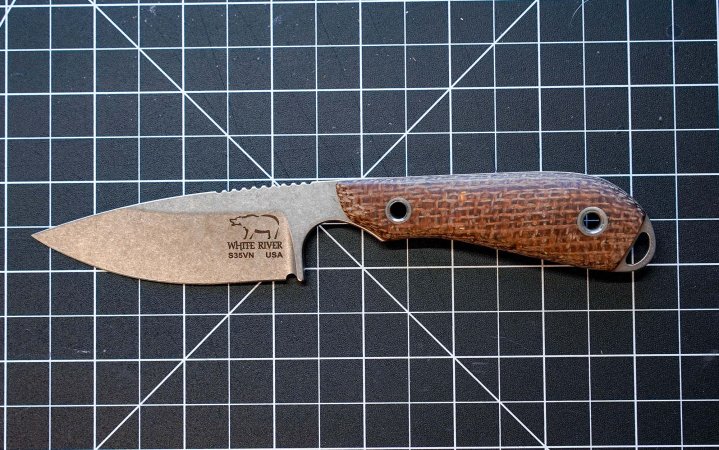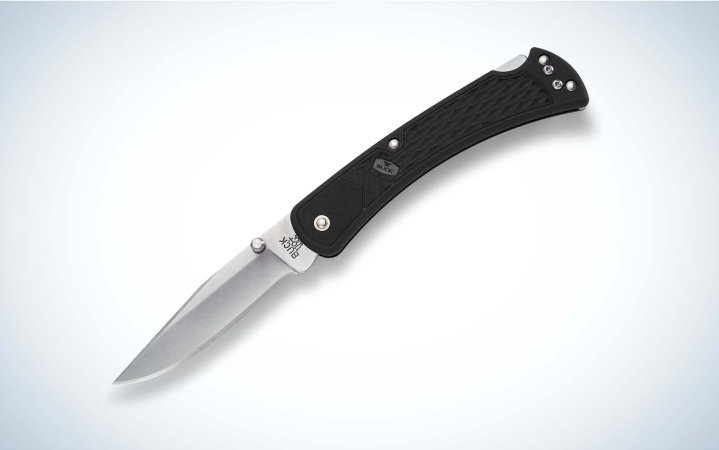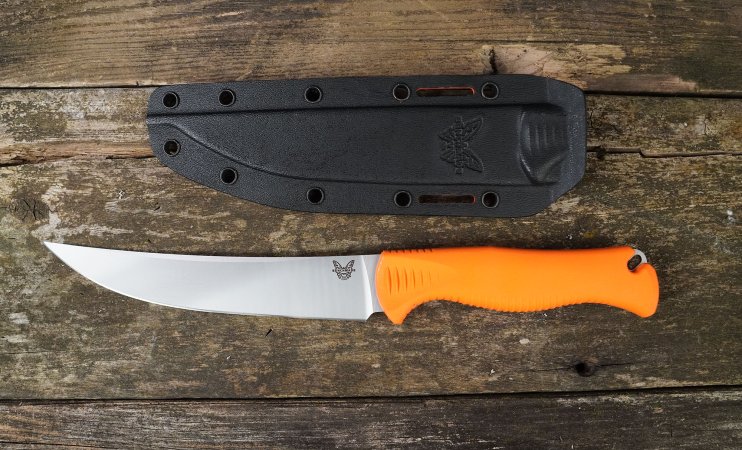We may earn revenue from the products available on this page and participate in affiliate programs. Learn More ›
Perhaps the most important task of hunting knives is processing game in the field and on the meat pole. For that a hunter needs a knife that slices and holds an edge. However, it also has to hold up to daily tasks like splitting kindling and cutting rope. We’ve selected several of the best hunting knives that we’ve tested with those qualities. Here are our top picks.
- Best Light Fixed Blade: Benchmade 15700 Flyway
- Best Replaceable Blade: Outdoor Edge Razorlite
- Best Handmade: Montana Knife Company Blackfoot 2.0
- Best for EDC: White River M1 Caper
- Best Folder: Buck 110 Slim
- Best No-Frills: Giantmouse GMF2
- Best Compact: CRKT BIWA
- Best Duck’s Head Knife: Outdoor Edge Duck Duo
- Best Butchering Knife: Benchmade Meatcrafter
- Best Survival Knife: Helle Utvaer
Best Hunting Knives: Reviews & Recommendations
Best Light Fixed Blade: Benchmade 15700 Flyway
Key Features
- Steel: CPM-154 at 58-61 HRC
- Blade Length: 2.7 inches
- Blade Thickness: 3/32 inches
- Weight: 2.1 ounces
- G10 Handles
- 14-degree bevel
- Kydex sheath
- Price: $180
Pros
- Good ergonomics
- Good edge retention
- Light
Cons
- Not ideal for hard-use tasks

On a mountain side in British Columbia I regretted my decision to bring an ultralight replaceable blade knife to quarter an elk. The blades popped out, needed to be changed often, got gummed up, and were flat out annoying to use. One of my hobbies is knife making, and when I got home I started working on a light fixed blade design. Then I stumbled across the Flyway and it was pretty close to my design.
So I got one in hand and put it to work on a whitetail. I used it to field dress and butcher the entire deer without touching up the blade. Two days later, I used it to butcher pheasants and quail.
Steel
According to Knife Steel Nerds, CPM 154 is tougher than S30V and known for its good edge retention. That toughness makes it a great steel choice for a thin knife and after my weekend of butchering, the knife could still push cut thin paper.
Blade Shape
The blade has a slight drop and plenty of belly for skinning. While field dressing, the fine point and slight drop were perfect for making the initial cut up the deer’s body. It’s also great for making skinning cuts where the knife edge is facing out as you slide the knife under the skin. The length makes it easy to control and when you’re reaching into a chest cavity, it’s easy to know where your knife is. For such a small blade it has a lot of belly, which is great for skinning and deboning.
Ergos

I rarely hold a skinning knife like a hammer or as I would a survival knife when making a feather stick. I use a pinch grip with my index finger on the knife’s spine. The Flyway’s sculpted G10 grip and spine jimping work well for that method. Especially the jimping that’s ¾ of the way down the blade. It serves not only to prevent slipping, but as an index point so you know where your finger is in relation to the point, even in the dark.

One nit pick on the ergos is the pinkie hook, which pushes the hand forward, a little too close to the edge.
Best Replaceable Blade Knife: Outdoor Edge Razorlite
Key Features
- Blade Length: 3.5 inches
- Blade Steel: Japanese 420J2 Stainless
- Nylon pouch
- Weight: 6.4 ounces
Pros
- Easy to replace blades
- Good blade shape
Cons
- Heavier than some replaceable blade knives
This year I found myself on the side of a mountain with five others trying to break down two elk on the side of the mountain as quickly as possible due to grizzly bears just a ridge over. Everyone had different replaceable blade knives, but about halfway through the first elk it was obvious, which of the knives was the best—the Razorlite. Its blades were the easiest to replace and the mounting system was trouble free. Other knives got gummed up and the blades came off, but the RazorLite chugged through deboning the two elk.


While the RazorLite isn’t the lightest replaceable blade knife—5.9 ounces heavier than a Tyto. It’s the most trouble-free design I’ve used. I don’t have blades pop off or break and can make it through an animal on one blade. When it’s time to swap a blade you just press the button, slide the blade out, and slide a new blade in. The rubberized group stays grippy when your hands are covered in blood. The 3.5-inch blade is a good length for balancing maneuverability and cutting efficiency. If weight isn’t a major concern and you want a replaceable blade knife, I’d recommend the Razorlite.
Best Handmade: Montana Knife Company Blackfoot 2.0
Key Features
- Weight: 3.6 ounces
- G10 Handle
- 52100 Steel
- Blade Length: 3.5 inches
- Overall Length: 7.75 inches
- Free sharpening
- Made in Montana
- Price: $300
Pros
- Handmade quality
- Versatile blade shape
- Great ergonomics
Cons
- Price
The ergonomics on the Blackfoot 2.0 are ideal, and it comfortably puts your hand into a natural position without forcing you into a specific grip. That means whether you’re whittling by the fire or making that delicate initial cut while field dressing, you’ll have a comfortable and controllable grip. Adding to the good grip are the sculpted G10 scales, which are a step above the standard flat scales on mass produced knives.
From the factory, the Blackfoot is very sharp and I’ve only needed to occasionally strop mine to keep it that way. It’s worth noting that Montana Knife Company offers lifetime sharpening. The full flat grind slices through meat like butter, and I think the blade shape is perfect for taking an animal from the field to a vacuum sealed bag.
The Blackfoot 2.0 uses 52100 steel, which isn’t the sexiest blade steel. However, 52100 has been around since 1905 and used for knives since at least 1940—so it’s time tested. According to Knife Steel Nerds, it has good toughness and doesn’t have the blade retention of higher chromium alloys. That means you don’t have to worry as much about chipping your edge when you smack into a bone, but you might want to have a honing rod handy while butchering. It’s also worth noting that it’s not a stainless steel and will need to be wiped dry before storage. So while many companies are quick to jump on the latest and greatest steels like Magnacut, it’s great to see a company utilizing a proven entity.
A $300 knife isn’t a small purchase, but consider that if you care for this blade, your grandchildren will use it to field dress their first deer. That heirloom quality shifts the value proposition for me. If you want a handmade knife and are capable of maintaining your tools, then the Montana Knife Company Blackfoot 2.0 is an excellent option.
Best for EDC: White River M1 Caper
Key Features
- Blade Length: 3 inches
- Overall Length: 7 inches
- Weight: 3.2 ounces
- Includes a Kydex sheath
- Blade Material: S35VN
- Micarta or G10 handles
- Made in USA
- Price: $175
Pros
- Light and easy to carry
- Very good ergonomics
- Would make a great hunting knife in addition to its EDC role
Cons
- Jimping is painfully sharp when cutting hard materials
There are a lot of valid reasons to carry a fixed blade, but I’ve always found that they come with too many compromises. The knives were either too big or they didn’t have enough handle real estate to offer an advantage over a folder. The M1 Caper is the best I’ve found at balancing a full grip and easy to carry size.
The handle is Croc comfortable and hiking boot secure. The deep choil gave me a lot of control over cuts and while I appreciated the sharp jimping, it was painfully sharp while cutting with a lot of force into wood. However, that sharp jimping is also what you want for a secure grip with bloody hands. It was among the best slicers I tested, so it’ll cut cardboard or quarter an elk with ease.
It comes with a Kydex sheath of good quality, but I would upgrade to an Armatus sheath for daily carry.
Read my test of the best EDC knives for more info.
Best Folder: Buck 110 Slim
Best Folder
Buck 110 Slim
Key Features
- Blade Length: 3.75 inches
- Overall Length: 8.6 inches (4.8 inches folded)
- Stainless 420 steel with BOS heat treat
- Lockback
- Glass Filled Nylon (GFN) handle material
- Weight: 2.8 ounces
- Price: $43
Pros
- Lightweight
- Under $50
- Made in the USA
Cons
- Not ideal for hard-use tasks
I own the original Buck 110, a fixed blade 110, and the newer 110 Slim. They’re all iconic hunting knives that have proven themselves through hard use by countless outdoorsmen. The best knife for field dressing among the 110 line is the 110 slim, because it’s light, is easier to open thanks to the addition of thumb studs, and blood effortlessly washes off the GFN handle. Fans of the original will be happy to learn that it maintains the classic, and rock solid, lockback design and endlessly useful clip point blade. It’s also one of the few knives under $50 that are made in the USA.
Buck Knives opened up shop in 1902, just four years after Outdoor Life, and have had a loyal following ever since. If you’re looking for a classic that won’t hurt the wallet or weigh you down, you can’t go wrong with the 110 Slim.
If you want to upgrade from the 110 Slim also check out the 110 Slim Pro TRX and 110 Hunter Sport.
More Great Hunting Knives
Picks by knife experts Matt Foster and Rick Spicer.
Best No-Frills: Giantmouse GMF2
Key Features
- Blade Length: 3.62 inches
- Blade Thickness: 0.157 inches
- Overall Length: 8.12 inches
- Weight: 4.1 ounces
- MSRP: $195
I was so impressed with the pocket clip EDC knife Giant Mouse sent for a previous review that I was excited to check out one of their fixed blades for use as a hunting knife. Unfortunately, they’re out of stock, but given the features and price point it’s not surprising why. The GMF2 is an old-school style, full tang fixed blade with profiled green canvas micarta scales attached to the side with fasteners and spacers. It’s nothing fancy, it’s just a tried and true way of putting together a solid, no frills fixed blade.
Made from Bohler N690 Cobalt steel, the shallow drop point blade will be a great general purpose field knife as well as hunting knife. The blade shape is well suited and could be used for a gutting knife, a skinning knife, and some processing. In keeping with the old-school motif, the sheath is a leather pouch style setup with an integral belt loop. With an MSRP of $195 it’s no wonder this knife was sold out at the time this was written. That’s okay though, we’ll wait.
Best Compact: CRKT BIWA
Key Features
- Blade Length: 3.02 inches
- Blade Thickness: 0.11 inches
- Overall Length: 6.63 inches
- Weight (with sheath): 2 ounces
- MSRP: $49.99
The BIWA is one the smallest knives of the group, and certainly the most svelte (yes, “svelte”). This is a fixed blade harkening back to the “trout and bird” knife days when people occasionally kept trout without being called heathens. Designed to offer good performance and economics, The BIWA has a 8Cr13MoV stainless steel, slender profile, full tang blade with a thin handle profile and nicely contoured G10 scales. This helps keep the weight of the knife to a mere 1.6 ounces, which is nice if you’re watching your weight on a backcountry hunt.
Read Next: The Ka-Bar Is America’s Most Famous Utility and Fighting Blade
While not necessarily designed with survival-type knife tasks in mind, the 3-inch blade length any hunting tasks you throw at it. The hard plastic, molded sheath holds the BIWA securely and it even comes with an optional belt loop that can be attached to the sheath if desired. Other than an included lanyard that’s too small to actually get over your hand, this is a great little knife.
Best Butchering Knife: Benchmade Meatcrafter
Benchmade Meatcrafter
Key Features
- Blade Length: 6.08 inches
- Blade Thickness: 0.09 inches
- Overall Length: 11.06 inches
- Weight: 3.24 ounces
- MSRP: $160
When Benchmade told us about the Meatcrafter, a high-end knife for processing game, did we want to include it in our round up of best hunting knives? Well yeah. The real work begins after the shot, right? And part of that hard, albeit rewarding work, is the final cutting required to put the meat on the table. This isn’t a rugged backcountry survival type fixed blade. It’s not supposed to be. Ultimately, this is a boning knife that has the right qualities to debone, trim, and break down primal cuts. Made from a new steel for Benchmade, powdered metal technology CMP-154, the 6-inch trailing point blade is relatively thin and somewhat flexible, which is why it lends itself so well to most meat processing tasks.
Processing can be messy business. Fortunately, the handle is made from over-molded Santoprene, a rubber-like material which helps maintain a great grip even with wet or bloody hands. Even though this may not be something you strap to your hip or pack, the Meatcrafter still comes with a molded Boltaron sheath worthy of a rugged field trip. This will be a great knife to have in camp, the kitchen, the shop or wherever you butcher your game.
Best Survival Knife: Helle Utvaer
Key Features
- Top wood cutter
- Scandi grind and full tang makes this durable and strong
- 4-inch blade
- Scandi grind
- 12C27 steel
Helle of Norway is a family company that’s been making high-quality knives for three generations. They excel at creating knives with razor-sharp scandi grinds, which are excellent for carving wood. While they make several capable models, I prefer the durability of the full-tang Utvaer. Its curly birch handle is functional and fits very well in medium sized hands. The stainless Sandvik 12C27 steel is thin, which makes for a very good slicing knife, while still durable. All that adds up to a survival knife with a good handle, rust resistance, and great blade performance. —Rick Spicer
Read Next: The Best Camping Knives of 2023
FAQs
Plenty of folks think you need a big knife for hunting big game animals, but that’s simply not true. A small, maneuverable, ultra-sharp blade is more effective for breaking down animals than a giant, unwieldly blade. A 3-inch to 3.5-inch blade is about perfect. Bigger knives with 5-inch blades and up are useful for handling camp work and bushcrafting tasks.
The best knife to gut deer with will have a sharp fine blade and a grip that won’t get slippery when it’s covered with blood. The all-time classic deer gutting knife is probably the Buck Knives’ Buck 110 folder, but the modern version many hunters choose is Havalon’s Prianta or a knive of a similar design.
Final Thoughts on the Best Hunting Knives
A hunting knife can be much more than a tool, it can be an heirloom that passes through the generations. Choose your next knife with longevity and practicality in mind and the next user will thank you for it.
- Best Light Fixed Blade: Benchmade 15700 Flyway
- Best Replaceable Blade: Outdoor Edge Razorlite
- Best Handmade: Montana Knife Company Blackfoot 2.0
- Best for EDC: White River M1 Caper
- Best Folder: Buck 110 Slim
- Best No-Frills: Giantmouse GMF2
- Best Compact: CRKT BIWA
- Best Duck’s Head Knife: Outdoor Edge Duck Duo
- Best Butchering Knife: Benchmade Meatcrafter
- Best Survival Knife: Helle Utvaer
